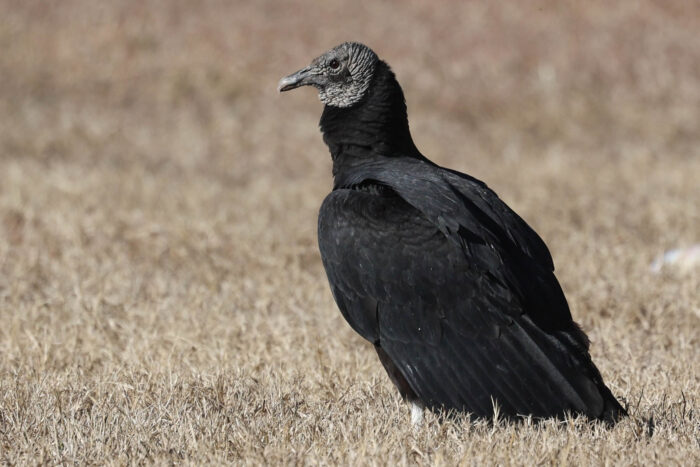Black Vulture
Coragyps atratus
The black vulture is a large raptor that scavenges and eats dead animals.
This section shows one large critter image at a time. Use the thumbnails that follow to select a specific image to display here.

This gallery contains a grid of small thumbnails. Selecting a thumbnail will change the main image in the preceding section.
Appearance
Black vultures are large raptors that have black feathers with white patches under their wings and have a small, bare head. Each vulture weighs about five pounds with a wingspan of five feet.
Feeding
As scavengers, black vultures will eat carrion (the flesh of dead animals) but they will occasionally hunt small mammals, birds and amphibians. They will also eat fruits and vegetables and are sometimes attracted to garbage piles. Black vultures do not have as strong of a sense of smell as turkey vultures so they will often fly higher than the turkey vultures and follow them to a carcass. They often feed in family groups.
Predators
Snakes and hawks can target juvenile black vultures.
Flight
Black vultures use thermal currents to soar high in the air while exerting minimal energy.
Voice
Black vultures make hissing and grunting noises. They lack a voice box so they do not call out in typical bird songs.
Reproduction and life cycle
As part of their courtship display, a pair of vultures will circle each other in the air and then on the ground the male will walk around the female in circles while extending his neck. Black vulture pairs are monogamous. They do not build nests and use tree cavities and caves as nesting sites.
A female will lay one to three eggs each nesting season. Both parents will incubate the egg and hunt and feed the young once they hatch. Parents closely guard their nest sites. Young are capable of flying about 80 days after hatching but tend to remain with their parents for several months.
Did you know?
- The black vulture population is currently stable but over half of the world’s vulture species are listed as endangered.
- Fragmenting lead bullets continue to be a threat for vultures and raptors in the Bay watershed. Using copper bullets or proper field dressing is important for reducing lead poisoning for local birds.
- Vultures are divided into two groups, New World Vultures and Old World Vultures. The two groups of vultures are only distantly related and evolved in different parts of the world at the same time with many of the same features.
- Vultures have weak feet that are designed for standing on carcasses not for carrying prey.
Sources and additional information
- Black Vulture - Audubon Guide to North American Birds
- Black Vultures in Maryland - Maryland Department of Natural Resources
- The Preserve’s Spotlight Species: Black Vulture - Virginia Outdoors Foundation
